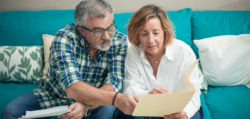
Your home, your retirement: Making the numbers work
The family home is the largest asset most people have in retirement. About 80% of retirees live in their own home and have access to the equity. Policymakers are reacting to this pool of wealth by making such access easier and more flexible.
On 1 January some significant changes to the so-called ‘downsizer’ legislation came into effect. These changes will make it far easier for many retirees to top up their income and to maximise their super savings, by using downsizer proceeds to better fund their retirement.
Today we share the first of a two-part article on the downsizer changes.
We’ve deliberately split our coverage of the changes as they are complex and related to different aspects of retirement income.
The first set of changes we will explain relate to using downsizer proceeds to contribute in a tax effective manner to your super.
The other set of changes deal with how Centrelink treats downsizer profits when means-testing for the Age Pension.
Eligibility just got easier
Today we are explaining the new eligibility rules for downsizer contributions to your super fund.
The age at which you can use this strategy has been lowered frequently and fast.
This time two years ago it was 65.
From July 1 last year it was decreased to 60.
And as of 1 January 2023, it is 55, thus encouraging the uptake of this special contribution for many Australians who are working full time and plan to do so for a while longer. Being able to take the profit from the sale of a home and put it into the tax-favoured environment of super is a useful strategy for many pre-retirees to consider.
There are many terms and conditions associated with downsizer legislation.
Here’s a short overview to remind you of the main rules
- ‘Downsizer’ legislation allows you to make a one-off superannuation contribution post-tax, up to $300,000 per individual.
- The money must come from the sale of your principal residence.
- There are other conditions also attached, such as residency and how long you have owned the home ( described here.)
- The legislation for such contributions is called ‘downsizing’ legislation, but the size of the home you sell and/or buy is irrelevant to the concessions.
- More than 50,000 Australians have taken advantage of this legislation as it is a useful strategy to top up your super and put your money in an environment where it will receive further tax concessions.
Tips and traps
1. Look before you leap
Whilst using this legislation looks attractive, it’s worth remembering that this strategy can only be used once. Let’s say you are 56 and plan to work for another 10 or so years. This strategy will allow you to realise wealth in your home and put it into super, if changing homes appeals. But it may help to seek advice to more accurately project the likely upside of a sale today, against one in a decade or so. Jumping in simply because you qualify age-wise is not necessarily your best tactic.
2. The deadlines matter
Another trap for new players is the deadline. You have just 90 days to make your downsizer contribution dated from receiving the proceeds of sale, which is usually at the date of settlement. You must also use the official downsizer contribution form.
3. Younger partner rules
These matter a lot. As a younger partner’s super is exempt from your assets and income testing if they are under Age Pension age and their super is still in an accumulation account. It is often useful for the downsizer contribution to be made to their super account, not yours. (this situation can also apply in the case of concessional super contributions). If you live as a couple, it is critical that you fully understand the ramifications of how and when to reinvest downsizing proceeds before you commit to this course of action.
Whilst the new legislation certainly makes downsizing more flexible and available to a larger portion of the population, there are significant upsides and downsides involved in this strategy. It’s important that you check all the rules that apply in your case, check that your understanding of these rules is correct, and then check again that you’ve got your sums right. There’s a lot to gain, but also a lot at stake. Our advisers can help.
Thinking about downsizing and the options available to you?
This article is provided by Retirement Essentials Representative Number: 001260855. We are an authorised representative of SuperEd Pty Ltd ABN 88 118 480 907 AFSL #468859. This information is not intended as financial product advice, legal advice or taxation advice. It does not take into account your personal situation, goals or needs and you should assess your own financial situation, consider if the information is suitable for you and ensure you read the relevant Product Disclosure Statement (PDS) if you choose to make any changes to your financial situation. It is always advisable to consult a financial adviser before making financial decisions.






At what age does this home investment cease meaning if I was 74 still working sold my home can I have that tax offset for till I finish work
We are considering the best option for an aging couple with increasing health problems. My plan, if I can get my wife to agree, is to sell the current home, which we have now lived in for 12 years, buy the next stage (something with potential support attached) mainly using money from other investments, and contribute the bulk of the house sale money to superannuation (where I hope it is safer and with better return) . Is this sound?
Hi Neil, thanks for joining the fun and well done planning ahead! If Retirement Essentials were to comment on your plan it would be considered personal advice so I cannot say I’m sorry. If you’d like to talk about it with someone you can trust we do offer advice consultations. The consultation can be either online or via phone call, goes for up to 45 minutes and costs $150.
CLICK HERE to book now.
Hi, Am I correct that by renting out our unit to move into a retirement village ( non-purchase) we would not be able to take advantage to put $300,000 each into our super funds?
Thanks mike
Hi Mike, thanks for seeking further clarity! You are correct, the additional amount is only allowed if the funds are coming from the sale of your former home.
Is downsizing rules also applicable to investment property? if yes, can we contribute to non-concessional super to benefit from capital gain tax?
Hi Hahn, thank you for your enquiry. Generally speaking the downsizing rules are not applicable to investment properties but each person’s situation is unique so to understand the rules correctly and the pros/cons applicable to you it would be best to book one of our Advice Consultations. The consultation can be either online or via phone call, goes for up to 45 minutes and costs $150.
CLICK HERE to book now.
Now that the superannuation rules have changed and there is no need to meet the work test in order to make after tax contributions ($110K every year or $330K every 3 years up to the day before you turn 75) downsizing contribution is not a big deal really?
Can you tell me how do you keep funds in a super fund (from a husbands deceased estate) without it effecting your pension.
Hi Helen, we can can over the pros/cons of your options with you via our consultation service which you can book HERE.